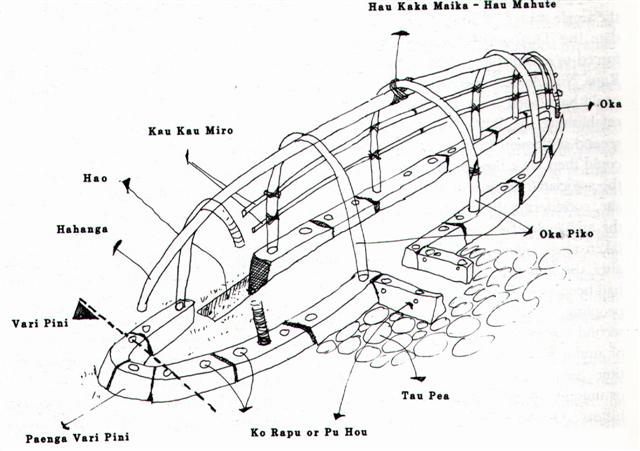5. Haga means a bay - presumably the harbour after a long sea voyage across the waters of the 'night' (winter) - where the canoe can be drawn up onto the sandy beach (like at Anakena). But there are various other possible meanings, for instance a fishtrap or a birdcage, ideas which should make us think of winter solstice respectively summer solstice:
Metoro said hagahaga at Ba8-19, a word which ought to mean the opposite of haga:
Between Ba8-19 and Ba8-20 a change has taken place. Maybe Ba8-19 refers to summer solstice and Ba8-20 to winter solstice. If we once again consult the Egyptian picture we can see a pair of upstretched arms not only at right bottom, but also where 'night' turns into 'day':
At 'midnight' the upraised arms are below the sky, as if receiving the newborn Son, but at bottom right the action takes place 'on the other side of the sky' and what happens is that the ship of Pharaoh is received in a kind of net (probably the 'black cloth'). Above the head of the goddess is not an oval (like a cartouche waiting for its name) but a headgear. The Mad Hatter (Mercury) rules beyond midsummer. The arms are held very high to make room for the headgear and also to indicate the sky of high summer. The bulging stomach is oriented at left in Ba8-19 but at right in Ba8-20, pointing in the direction of the season of affluence in both cases:
The uplifted arms in Ba8-19 are both convex towards left, but in Ba8-20 they are rather symmetric, signs we do not understand as yet. The pair of uplifted arms should have been there in Gb8-30 and Ga1-1 too if the time had been a solstice:
But 472 days is a cycle which goes beyond the normal year. Maybe the signs of 'double yet still the same' are there in order to make us think of winter solstice. Maybe the absence of a pair of uplifted arms is a sign to make us realize that it cannot be winter solstice. Our conclusion as readers would then be to think of something similar to a winter solstice, and the interpretation surely would be the 'winter solstice' of the great cycle of Moon. Instead of the single 'head' of Sun (as in Ba8-19) there are 2 'heads' (for the Waxing and Waning 'faces' of Moon). If Metoro had read the G text for Bishop Jaussen he possibly could have said hahaga at Ga1-1, because with haga for the part at top right in the glyph he could have connected the left part with the first part of haga, viz. ha:
Ha means 4 and hahaga can therefore be interpreted as the 'harbour' of 'number 4', or the 'summit' of the 'year' with 4 * 4 = 16 lunar synodic months. Hahaga is noted as the name of the ridgepole of a hare paega, i.e. it can symbolize the middle of the night:
To read hahaga at Ga1-1 is not a case of reading 'rebus fashion' because the connection between the word hahaga and the idea illustrated in Ga1-1 is not severed. The word is not cut off from its right context. Hahaga could conceivably be a wordplay, to be understood also as haha-ga, the location (ga) of the 'mouth' (haha), viz. to indicate the opening ('mouth') of the year:
Such a wordplay could survive 'translation' into the glyph of Ga1-1 if we imagine there is an open mouth (ready to eat) at top right. It would indeed be quite difficult to understand why haha means not only 'mouth' but also 'to carry piggy-back' without realizing the connection between ha-haga (the 'ridgepole' of the year) and haha-ga (the place of the 'entrance' to the year). |




